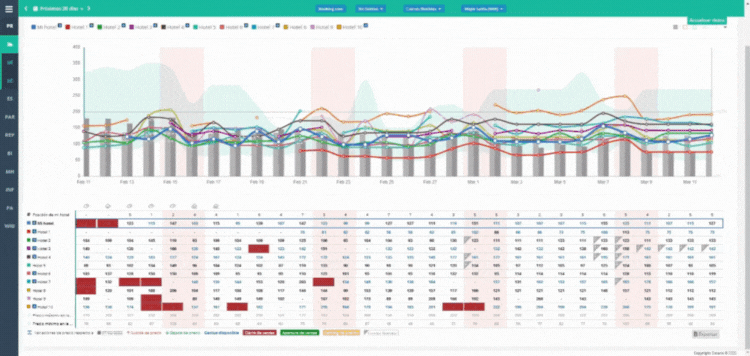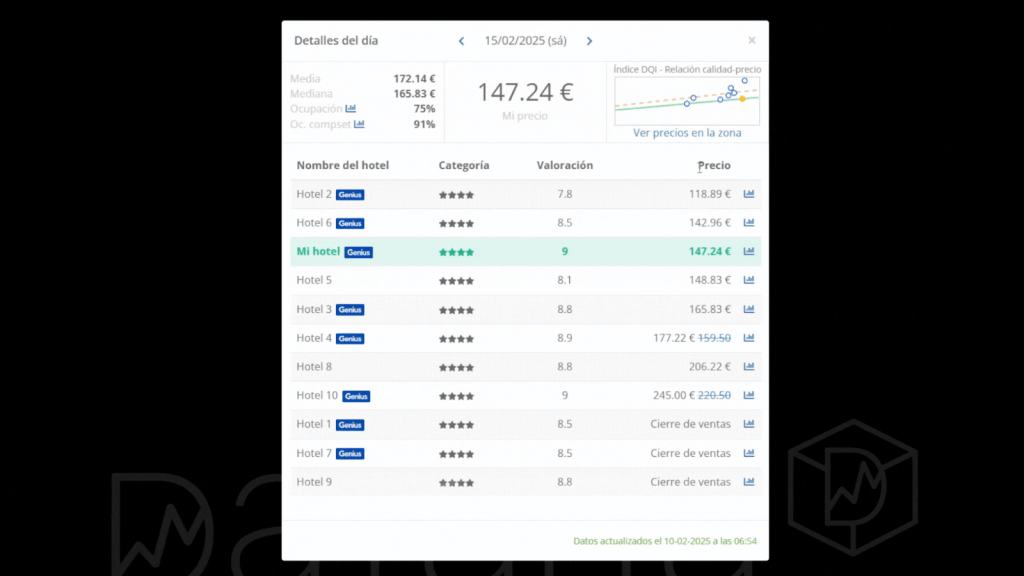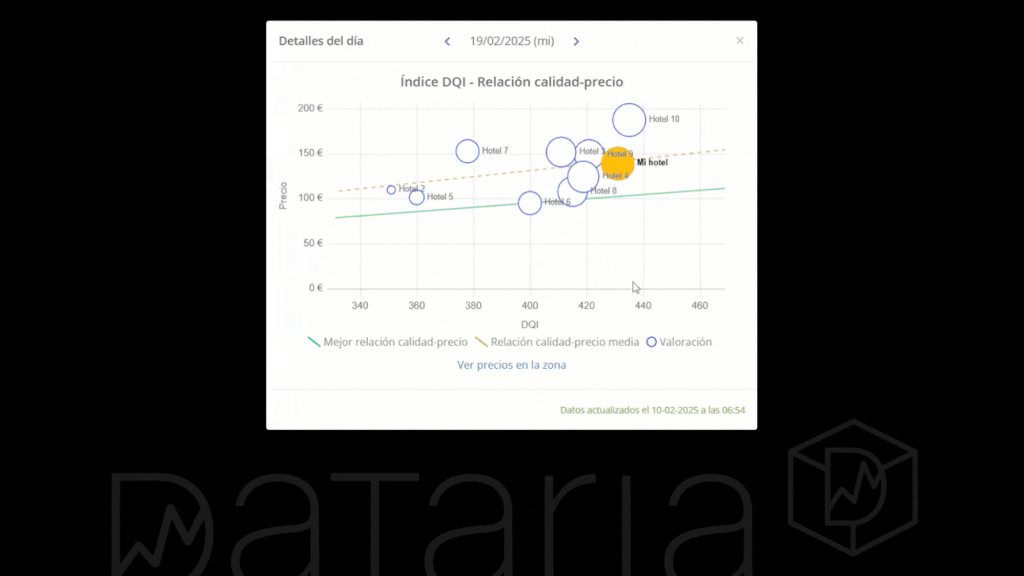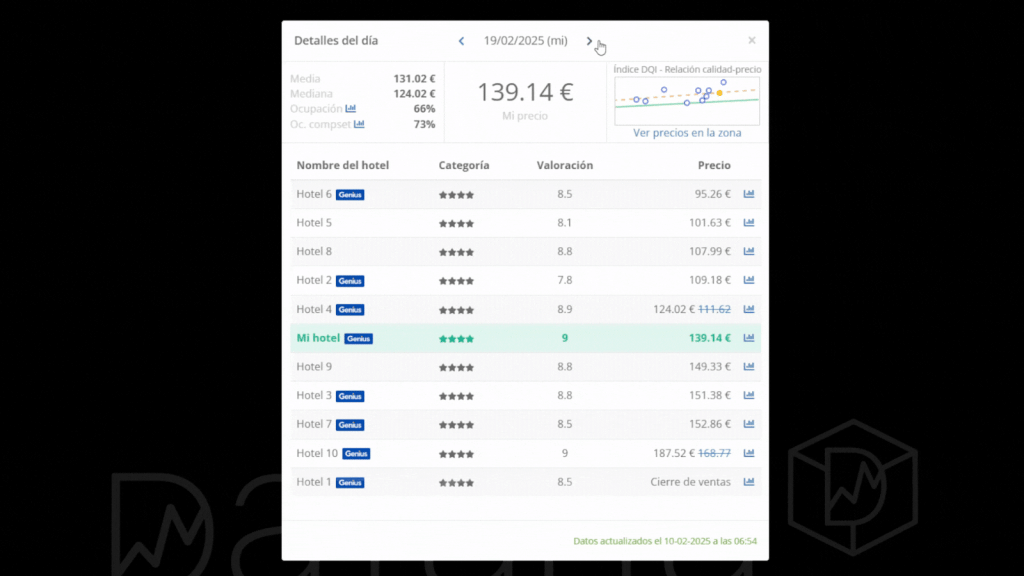Often, the Impact of price–quality perception on hotel reservations is often underestimated. When a traveller chooses a hotel, how they perceive the balance between what they pay and what they get can be a decisive factor. While a competitive rate can attract attention, it’s often not enough on its own. What truly influences conversions is an experience that meets—or exceeds—the expectations set by the price.
The real impact of price–quality preception on hotel reservations
Understanding the impact of price–quality perception on hotel reservations is key when evaluating booking behaviour. Prospective guests frequently compare prices and reviews across booking platforms. If your hotel offers the lowest rate but appears to fall short in quality, your position in the decision-making process may be compromised. On the other hand, when perceived value and pricing align, conversion rates are likely to rise.
A scatter chart can help you visualise this relationship clearly. With this kind of visual data, it becomes easier to define a distinct market positioning strategy within your compset and improve your booking performance.
💡 How to enhance the perceived value of your hotel
Take control again of your hotel’s booking strategy by understanding the impact of price–quality perception on reservations
- 1. Optimise your online reputation
- Encourage satisfied guests to leave reviews on key booking platforms. Higher ratings boost visibility and foster trust.
- 2. Offer a value-consistent experience
- Ensure your service quality aligns with your pricing. This strengthens the perceived value and encourages repeat bookings.
- 3. Adjust your pricing strategy
- Evaluate the price–quality positioning of your compset regularly. This can be a time-consuming task if done manually—especially when analysing long date ranges for proper market benchmarking. Without tools like a rate shopper, keeping up with daily rate changes becomes a demanding routine.
📐 How to know if your hotel is well positioned in this balance? Look at the impact of price–quality perception on hotel reservations
To implement this last recommendation—adjusting rates according to market behaviour and your hotel’s position relative to the competition—we’ve developed a very useful indicator at Dataria: the DQI Index –or th price–quality perception index. This index is a key tool for assessing your market positioning and optimising your pricing.
A good example of how value for money perception influences booking decisions is the “Value for money” score on Booking.com. This metric, based on real guest reviews, reflects how guests rate their experience relative to the price paid. Much like Dataria’s DQI Index, this score acts as a benchmark for evaluating perceived value.
Both indicators offer essential insights into how well your price aligns with quality. With this knowledge, you can fine-tune your strategy to boost competitiveness and drive more bookings.
📊 The DQI Index – A smarter way to monitor value for money
So, how can you know if your hotel is well positioned in this balance of value and price? At Dataria, we’ve developed the DQI Index – Value for Money, a powerful indicator that helps you understand your pricing in relation to perceived quality across your compset.
This tool is essential for anyone looking to measure the impact of price–quality perception on hotel reservations, offering a strategic view based on guest expectations and competitive pricing.
What does the DQI measure?
The DQI (Dynamic Quality Index) is an algorithm-based indicator that evaluates the relationship between price and quality among hotels in your compset. It compares minimum nightly rates (for double occupancy) and aggregates public review scores from major booking channels.
This gives you visibility into:
- Your market positioning: See how you stack up against competitors and whether your offering justifies your pricing.
- Trends over time: Track how perceptions shift and adapt your strategy accordingly.
- Guest sentiment vs. pricing: Understand how online reputation impacts perceived value and how that translates into bookings.
Note: The DQI does not account for meal plans or room types—just price and review scores.
📍 Where to find the DQI in the Rate Shopper
To access the DQI, go to the ‘Complete Analysis’ section of Dataria’s Rate Shopper module. Click any price in the bottom table and a pop-up will appear. In the top-left corner, you’ll see a thumbnail of the scatter plot—click it to view the detailed chart.

You’ll be able to:
- See how your hotel is positioned relative to competitors.
- Track trends across multiple days.
- Review absolute values (%) per competitor.

📉 How to read the DQI scatter chart
This visual representation clearly displays the impact of price–quality perception on hotel reservations, by comparing two main data points:
- Horizontal axis (Price): Further right = higher price
- Vertical axis (Guest rating): Higher up = better guest reviews

Each dot represents a hotel:
- Dot size: Indicates the hotel’s rating score.
- Positioning: Reflects the relationship between price and perceived quality.
What does this mean for your hotel?
If your dot is in the lower-left corner (low price, low rating), this suggests poor perceived value—something worth addressing. If you’re in the upper-right (high price, high rating), you’re likely offering good value, but may still have room to refine your strategy based on competitors’ behaviour.

You can also configure which competitors are included by adjusting the price range from the ‘Settings’ menu—this ensures the analysis focuses on your true compset.
🚀 From data to strategy: understand the impact of price–quality perception on hotel reservations.
With powerful tools like the DQI and Dataria’s updated Rate Shopper, you no longer need to rely on assumptions. By understanding the impact of price–quality perception on hotel reservations, you gain the strategic edge needed to optimise rates, improve reputation, and increase bookings.

Would you like to explore this further?
👉 Request a demo and see how Dataria can help you enhance your value proposition—without increasing your workload.


